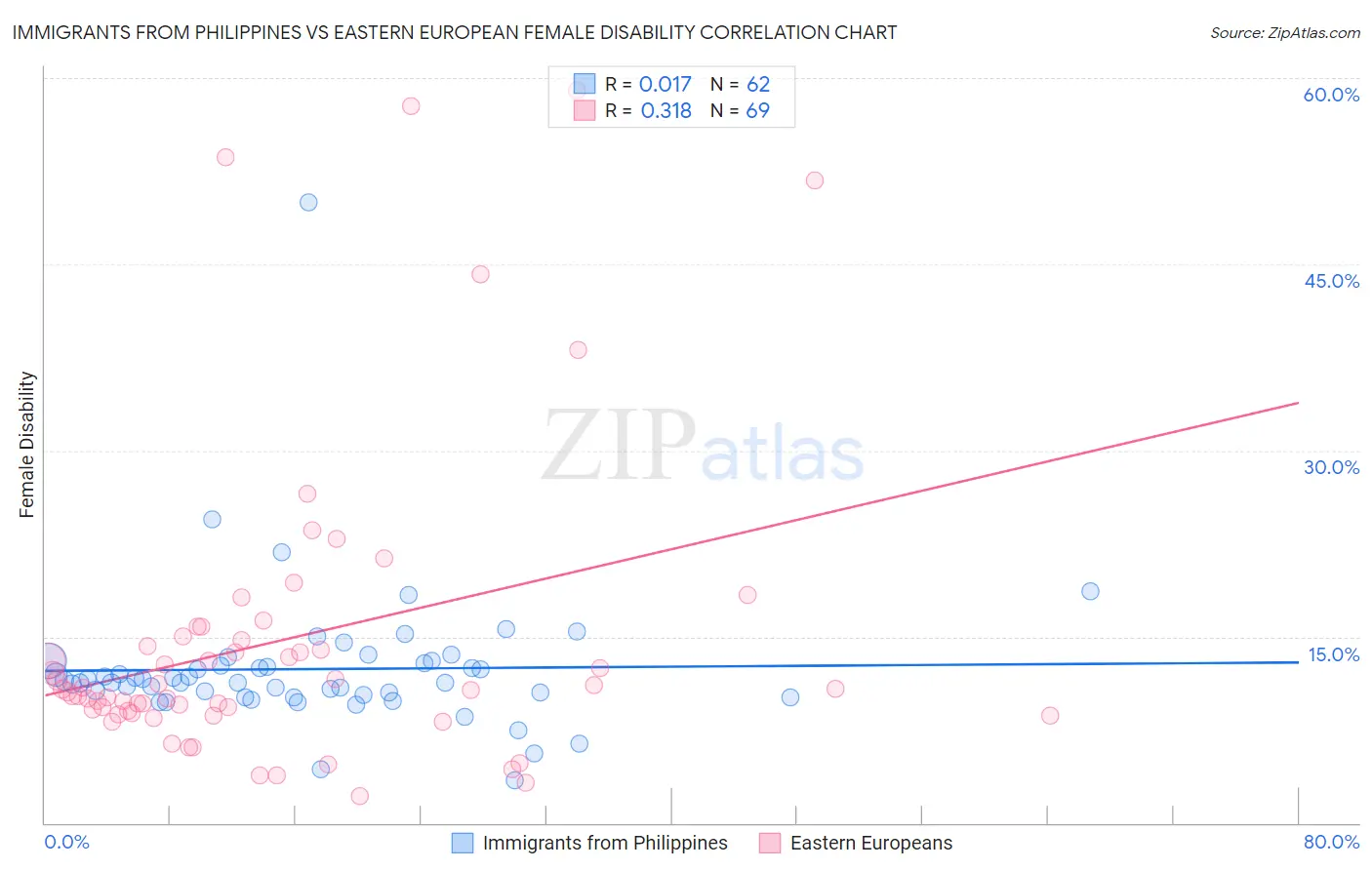Immigrants from Philippines vs Eastern European Female Disability
COMPARE
Immigrants from Philippines
Eastern European
Female Disability
Female Disability Comparison
Immigrants from Philippines
Eastern Europeans
11.7%
FEMALE DISABILITY
98.6/ 100
METRIC RATING
99th/ 347
METRIC RANK
11.5%
FEMALE DISABILITY
99.7/ 100
METRIC RATING
81st/ 347
METRIC RANK
Immigrants from Philippines vs Eastern European Female Disability Correlation Chart
The statistical analysis conducted on geographies consisting of 471,161,268 people shows no correlation between the proportion of Immigrants from Philippines and percentage of females with a disability in the United States with a correlation coefficient (R) of 0.017 and weighted average of 11.7%. Similarly, the statistical analysis conducted on geographies consisting of 461,176,022 people shows a mild positive correlation between the proportion of Eastern Europeans and percentage of females with a disability in the United States with a correlation coefficient (R) of 0.318 and weighted average of 11.5%, a difference of 1.5%.

Female Disability Correlation Summary
| Measurement | Immigrants from Philippines | Eastern European |
| Minimum | 3.4% | 2.2% |
| Maximum | 50.0% | 59.0% |
| Range | 46.6% | 56.8% |
| Mean | 12.4% | 14.7% |
| Median | 11.4% | 10.8% |
| Interquartile 25% (IQ1) | 10.3% | 8.9% |
| Interquartile 75% (IQ3) | 12.8% | 14.8% |
| Interquartile Range (IQR) | 2.6% | 5.9% |
| Standard Deviation (Sample) | 5.9% | 12.3% |
| Standard Deviation (Population) | 5.9% | 12.2% |
Demographics Similar to Immigrants from Philippines and Eastern Europeans by Female Disability
In terms of female disability, the demographic groups most similar to Immigrants from Philippines are Immigrants from Uruguay (11.7%, a difference of 0.050%), Uruguayan (11.7%, a difference of 0.21%), Korean (11.7%, a difference of 0.35%), Immigrants from Russia (11.7%, a difference of 0.36%), and Immigrants from Northern Europe (11.6%, a difference of 0.82%). Similarly, the demographic groups most similar to Eastern Europeans are Immigrants from Jordan (11.5%, a difference of 0.14%), Luxembourger (11.6%, a difference of 0.19%), Immigrants from Serbia (11.6%, a difference of 0.21%), Immigrants from Poland (11.6%, a difference of 0.24%), and Palestinian (11.6%, a difference of 0.27%).
| Demographics | Rating | Rank | Female Disability |
| Immigrants | Jordan | 99.7 /100 | #80 | Exceptional 11.5% |
| Eastern Europeans | 99.7 /100 | #81 | Exceptional 11.5% |
| Luxembourgers | 99.6 /100 | #82 | Exceptional 11.6% |
| Immigrants | Serbia | 99.6 /100 | #83 | Exceptional 11.6% |
| Immigrants | Poland | 99.6 /100 | #84 | Exceptional 11.6% |
| Palestinians | 99.6 /100 | #85 | Exceptional 11.6% |
| Immigrants | Cameroon | 99.6 /100 | #86 | Exceptional 11.6% |
| Immigrants | Denmark | 99.5 /100 | #87 | Exceptional 11.6% |
| Yup'ik | 99.5 /100 | #88 | Exceptional 11.6% |
| Vietnamese | 99.5 /100 | #89 | Exceptional 11.6% |
| Immigrants | Romania | 99.5 /100 | #90 | Exceptional 11.6% |
| Immigrants | Zimbabwe | 99.5 /100 | #91 | Exceptional 11.6% |
| Immigrants | Czechoslovakia | 99.5 /100 | #92 | Exceptional 11.6% |
| Immigrants | Sierra Leone | 99.4 /100 | #93 | Exceptional 11.6% |
| Immigrants | Brazil | 99.4 /100 | #94 | Exceptional 11.6% |
| Immigrants | Northern Europe | 99.4 /100 | #95 | Exceptional 11.6% |
| Immigrants | Russia | 99.0 /100 | #96 | Exceptional 11.7% |
| Koreans | 99.0 /100 | #97 | Exceptional 11.7% |
| Uruguayans | 98.8 /100 | #98 | Exceptional 11.7% |
| Immigrants | Philippines | 98.6 /100 | #99 | Exceptional 11.7% |
| Immigrants | Uruguay | 98.5 /100 | #100 | Exceptional 11.7% |